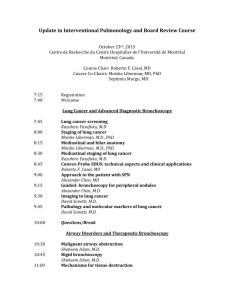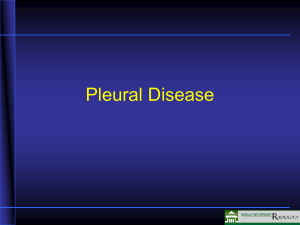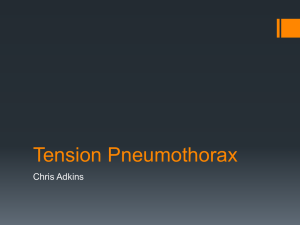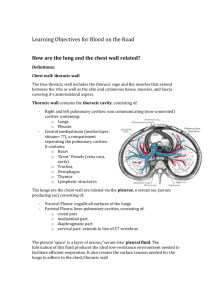Pathology Ch 15 678-679 AND 731-734
advertisement
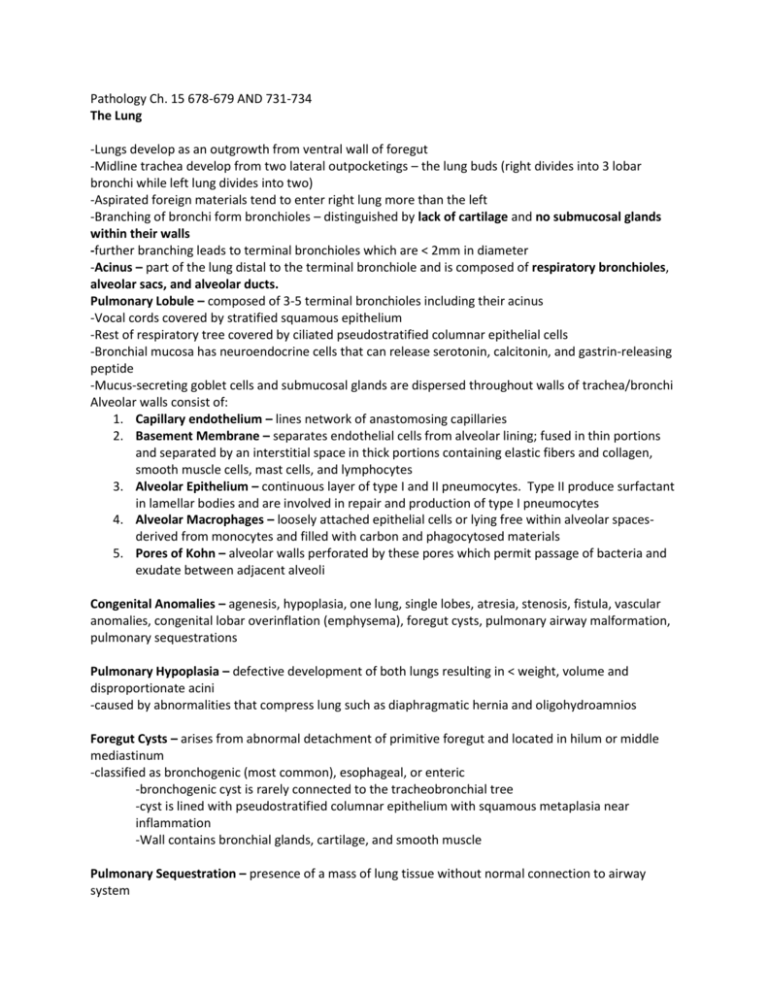
Pathology Ch. 15 678-679 AND 731-734 The Lung -Lungs develop as an outgrowth from ventral wall of foregut -Midline trachea develop from two lateral outpocketings – the lung buds (right divides into 3 lobar bronchi while left lung divides into two) -Aspirated foreign materials tend to enter right lung more than the left -Branching of bronchi form bronchioles – distinguished by lack of cartilage and no submucosal glands within their walls -further branching leads to terminal bronchioles which are < 2mm in diameter -Acinus – part of the lung distal to the terminal bronchiole and is composed of respiratory bronchioles, alveolar sacs, and alveolar ducts. Pulmonary Lobule – composed of 3-5 terminal bronchioles including their acinus -Vocal cords covered by stratified squamous epithelium -Rest of respiratory tree covered by ciliated pseudostratified columnar epithelial cells -Bronchial mucosa has neuroendocrine cells that can release serotonin, calcitonin, and gastrin-releasing peptide -Mucus-secreting goblet cells and submucosal glands are dispersed throughout walls of trachea/bronchi Alveolar walls consist of: 1. Capillary endothelium – lines network of anastomosing capillaries 2. Basement Membrane – separates endothelial cells from alveolar lining; fused in thin portions and separated by an interstitial space in thick portions containing elastic fibers and collagen, smooth muscle cells, mast cells, and lymphocytes 3. Alveolar Epithelium – continuous layer of type I and II pneumocytes. Type II produce surfactant in lamellar bodies and are involved in repair and production of type I pneumocytes 4. Alveolar Macrophages – loosely attached epithelial cells or lying free within alveolar spacesderived from monocytes and filled with carbon and phagocytosed materials 5. Pores of Kohn – alveolar walls perforated by these pores which permit passage of bacteria and exudate between adjacent alveoli Congenital Anomalies – agenesis, hypoplasia, one lung, single lobes, atresia, stenosis, fistula, vascular anomalies, congenital lobar overinflation (emphysema), foregut cysts, pulmonary airway malformation, pulmonary sequestrations Pulmonary Hypoplasia – defective development of both lungs resulting in < weight, volume and disproportionate acini -caused by abnormalities that compress lung such as diaphragmatic hernia and oligohydroamnios Foregut Cysts – arises from abnormal detachment of primitive foregut and located in hilum or middle mediastinum -classified as bronchogenic (most common), esophageal, or enteric -bronchogenic cyst is rarely connected to the tracheobronchial tree -cyst is lined with pseudostratified columnar epithelium with squamous metaplasia near inflammation -Wall contains bronchial glands, cartilage, and smooth muscle Pulmonary Sequestration – presence of a mass of lung tissue without normal connection to airway system -blood supply comes from aorta and not pulmonary arteries -Extralobar sequestrations are external to the lung and may be located anywhere in the thorax -most common in INFANTS as abnormal mass lesions -Intralobar sequestration are within lung structures and occur in OLDER children and associated with recurrent infection or bronchiectasis Atelectasis – incomplete expansion of lungs (neonatal atelectasis) or collapse of previously inflated lung, producing areas of relatively airless pulmonary parenchyma Aquired atelectasis in adults is divided into resorption, compression, and contraction atelectasis 1. Resorption Atelectasis – complete obstruction of an airway which leads to resorption of O2 trapped in dependent alveoli without impairment of blood flow through alveolar walls a. Mediastinum shifts TOWARD the atelectatic lung b. Caused by excessive secretions of mucus or exudates within smaller bronchi, and is most often found in asthma, bronchitis, bronchiectasis, post op states, aspiration of foreign bodies, and rarely neoplasms 2. Compression Atelectasis – results when pleural cavity is partially or completely filled with fluid exudate, tumor, blood, or air (pneumothorax), or tension pneumothorax when air pressure impinges on function of lung and mediastinum a. Mediastinum shifts AWAY from atelectatic lung 3. Contraction Atelectasis – occurs when local or generalized fibrotic changes in lung or pleura prevent full expansion -Atelectasis reduces oxygenation and predisposes to infection -Reversible disorder except that caused by contraction Pleural Effusion – primary and secondary pleural disease and can either be inflammatory or noninflammatory -Accumulation of pleural fluid happens due to: -Increased hydrostatic pressure (congestive heart failure) -Increased vascular permeability (pneumonia) -Decreased osmotic pressure (nephrotic syndrome) -Increased intrapleural negative pressure (atelectasis) -Decreased lymphatic drainage (mediastinal carcinomatosis) Inflammatory Pleural Effusions – serious, serofibrinous, and fibrinous pleuritis caused by same process -fibrinous exudations reflect a more severe exudative reaction -common causes of pleuritis are tuberculosis, pneumonia, lung infarcts, lung abscess, and bronchiectasis -rheumatoid arthritis, disseminated lupus, uremia, infections and metastasis can cause serous or serofibrinous pleuritis -Radiation for tumor therapy can cause serofibrinous pleuritis -Most cases show serofibrinous reaction is minimal and fluid exudate is resorbed with either resolution or organization of fibrinous component Empyema – purulent (discharging pus) pleural exudate that results from bacterial or mycotic seeding of pleural space -occurs due to spread of organisms from pulmonary infection or lymphatic or hematogenous dissemination from more distant source -rarely infections from below diaphragm extend into pleura, but if so, mainly on right side -characterized by loculated, yellow-green, creamy pus composed of neutrophils admixed with other leukocytes -usually small volume and localized -may resolve on its own, but may also form dense fibrous adhesions that restrict pulmonary expansion Hemorrhagic Pleuritis manifested by bloody exudates is infrequent and found in hemmorhagic diatheses, rickettsial diseases, and neoplastic involvement (different from hemothorax) Noninflammatory Pleural Effusions – collections of serous fluid within pleural cavities (Hydrothorax) -uni- or bi- lateral depending on cause -most common cause of hydrothorax is cardiac failure and is accompanied by edema/pulmonary congestion -Discharge may collect in other systemic disease associated with edema and is found in renal failure and cirrhosis of liver -Hemothorax –escape of blood into pleural cavity -fatal complication of ruptured aortic aneurysm or vascular trauma (may occur post-op) -pure hemothorax identified by large clots that accompany fluid component of blood -Chylothorax – accumulation of milky fluid of lymphatic origin in pleural cavity (milky white due to emulsified fats) -most often caused by thoracic duct trauma or obstruction that secondarily causes rupture of major lymphatic vessels Pneumothorax – air or gas in pleural cavities that can be spontaneous, traumatic, or therapeutic. -spontaneous pneumothorax may complicate disease that causes rupture of alveolus, or caused by abscess that communicates directly with pleural space or with the lung interstitial tissue **Pneumothorax is most commonly associated with emphysema, asthma, and tuberculosis -traumatic pneumothorax is caused by perforating injury to chest wall -resorption of pleural space occurs in spontaneous and traumatic pneumothorax if it seals Spontaneous Idiopathic Pneumothorax – encountered in young people and is due to rupture of small, peripheral, usually apical subpleural blebs, and usually subsides spontaneously as air is resorbed -Pneumothorax can cause compression, collapse, and atelectasis of lung and responsible for certain respiratory distress Tension Pneumothorax – when lung collapse defects acts as a flap where lung can come in but not out Pleural Tumors – pleura can be involved in primary or secondary tumors (secondary metastasis more common) -most frequent metastasis is from lung and breast, but can spread from any organ -most metastatic involvement includes serous or serosanguineous effusion that contains neoplastic cells Solitary Fibrous Tumor – also called Benign Mesothelioma in the pleura and Fibroma in the lung. -attached to pleural surface by a pedicle, may be small or large -consists of dense fibrous tissue with occasional cysts filled with viscid fluid (lots of reticulin and collagen fibers which are interspersed with spindle cells like fibroblasts -Rarely malignant -Tumors are CD34+ and keratin negative, diagnostically distinguishable from malignant mesothelioma -No relationship to asbestos Malignant Mesothelioma – arise from visceral or parietal pleura, associated with asbestos exposure -Lifetime risk for exposed individuals is 7-10% (not related to smoking) -Malignant mesothelioma is in contrast with asbestos-related lung carcinoma – which is magnified by smoking -Asbestos bodies are found in increased numbers in lungs of patients with mesothelioma -60%-80% of malignant mesotheliomas have deletions in chromosomes 1p, 3p, 6q, 9p, 22q and 31% have p16 mutations -low frequency of p53 mutations, although p53 accumulation occurs in 70% of mesotheliomas -SV40 virus has been found in mesotheliomas Morphology of Malignant Mesothelioma – diffuse lesion that spreads in pleural space and is associated with pleural effusion and invasion of thoracic structures -affect lung becomes ensheathed by thick layer of soft pink tumor tissue -may be epithelioid (60%), sarcomatoid, or mixed (mesothelial cells can make both types of cells) Epithelioid Type consists of cuboidal, columnar, or flattened cells forming tubular or papillary structures resembling adenocarcinoma -Features that favor mesothelioma over adenocarcinoma are: 1. Positive staining for mucopolysaccharide, inhibited by previous digestion by hyaluronidase 2. Lack of staining for carcinoembryonic antigen and other epithelial glycoprotein antigens 3. Strong staining for keratin proteins that are perinuclear rather than peripheral 4. Positive staining for calretinin, WT-1, cytokeratin 5/6, and D2-40 5. Presence of long microvilli and tonofilaments under electron microscopy, but absent microvillous rootlets and lamellar bodies Mesenchymal Type of mesothelioma appears as spindle cell sarcoma, resembling fibrosarcoma Clinical Course of Mesothelioma – chest pain, dyspnea, recurrent pleural effusions -lung is invaded directly and often metastatic spread to hilar lymph nodes and to liver and other organs -50% of patients die within 12 months of diagnosis and few survive longer than 2 years -Aggressive therapy seems to improve poor prognosis in epithelioid mesothelioma -Can also arise in peritoneum, pericardium, tunica vaginalis, and genital tract -Peritoneal mesotheliomas are particularly related to asbestos exposure, and 50% of such patients have pulmonary fibrosis, leads to death from intestinal obstruction or inanition


